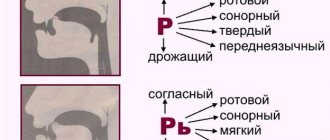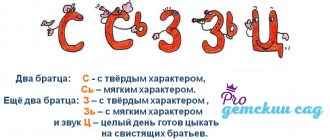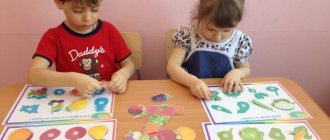Article:
1. “Calm the doll”
Goal: development of voice power.
Description of the game: children sit on chairs in a semicircle. They have dolls in their hands. The teacher says: “The dolls are crying, we need to calm them down. Look how I put the doll to sleep (rocks the doll, quietly humming the tune of a familiar lullaby). Now you shake it.” Children take turns and then rock the dolls together, pronouncing the sound a .
2. “Blizzard”
Goal: development of voice strength and speech breathing. Activation of the lip muscles.
Equipment: story picture “Blizzard”.
Description of the game: the teacher shows a picture of a blizzard. Children sitting in a row depict a blizzard howling on a stormy evening. At the signal from the teacher, “The blizzard is beginning,” they quietly say: oooh...; at the signal “The blizzard is ending” they speak more quietly; at the signal “The blizzard is over” they fall silent. It is advisable that children change the strength of their voice at least 2-3 times in one exhalation. In this case, it is more convenient to replace the teacher’s verbal instructions with conducting: a smooth movement of the hand up - the children speak louder, a smooth movement of the hand down - the children speak more quietly.
- "Beep"
Goal: same as in the previous game.
Description of the game: children stand in a row facing the teacher and raise their arms up from the sides, touching with their palms, but do not clap. Then slowly lower it down through the sides. Simultaneously with lowering their hands, children pronounce the sound u, first loudly, and then gradually more and more quietly. They lower their hands and fall silent.
First, the teacher himself shows the actions, then calls two children who perform the actions together with him and pronounce the sound, the rest of the children only make movements with their hands. Then the whole group plays.
4. “Who wins?”
Goal: development of voice strength and speech breathing. Activation of the muscles of the lips and lower jaw.
Description of the game: the teacher calls two children and puts them facing each other. At the teacher’s signal, the children simultaneously begin to draw out, first quietly, then loudly, the vowel sounds a, o, u, i, e.
- "The wind blows"
Goal: development of voice strength and speech breathing.
Description of the game: children and teacher stand in a circle. The teacher says: “We went for a walk in the forest in the summer.” Everyone joins hands and leads a round dance, and the teacher continues: “We are walking through the field, the sun is shining, a light breeze is blowing and the grass and flowers are swaying.” The teacher and children stop. “The wind blows quietly, like this: v-v-v (pronounces the sound v quietly and for a long time). The children repeat after him. Then the movement of the round dance continues under the leisurely speech of the teacher: “We came to the forest. We picked a lot of flowers and berries. We got ready to go back. Suddenly a strong wind blew: v-v-v...” - the teacher pronounces this sound loudly and for a long time. Children stop and repeat the sound after the teacher. Methodological instruction: the teacher makes sure that the children, repeating after him, maintain the same strength of voice.
6. “Dashes”
Goal: development of voice power. Activation of the lip muscles.
Equipment: chalk, chairs.
Description: children go to their homes (outlined circles, corners of the room, chairs). At the teacher’s signal, one of the children calls another of his choice, “Ay, ay, Petya.” Petya, in turn, answers him: “Ay, ay, Vova,” and they quickly change places. Then Petya chooses another comrade and changes places with him in the same way.
- "The wolf and the seven Young goats"
Goal: development of strength, pitch and expressiveness. Improving phrasal speech.
Equipment: animal masks.
Description: children must first be familiar with the fairy tale, know the words of the goat and the wolf well, and the answers of the kids. The teacher distributes roles among the children and distributes masks. The teacher draws the children's attention to the nature of the voices. The goat and kids should speak in thin, high voices, and the wolf - first in a rough, low voice, and then in a higher voice.
Stages of correctional work to correct voice disorders in children
Psychotherapy.
Occupies a significant place in correctional work. The main goal of psychotherapy is to improve the mental health of children. Direct psychotherapy also has a healing effect on children being trained.
Indirect psychotherapy refers to the setting, the team, the attitude of the staff, the regimen, games, etc.
Direct psychotherapy is a therapeutic effect of words in the form of explanation, persuasion, suggestion and training.
In modern psychotherapy, there are two main types of verbal influence: rational and suggestive therapy.
For young children, rational psychotherapy is expressed in the use of a variety of play techniques, colorful didactic material, labor, music, and rhythm. These forms of psychotherapy are closely related to psychoprophylaxis and mental hygiene.
Correction of physiological and phonation breathing.
The basis of high-quality voice formation is the correct organization of speech exhalation or breathing support.
Breathing supports is a term used in speech and vocal pedagogical practice, defining the conscious slowing of the exhalation phrase, thanks to the precise coordinated work of the muscles - inhalers and exhalers. The support of breathing causes a peculiar sensation of a column of air, supported below by the abdominal muscles and resting on the palatine vault.
The supporting belt of the voice is the abdominal and back muscles. The voice is formed in the lower abdomen. The main task of a speech therapist is to coordinate the work of these muscles with voice guidance. Voice is voiced breathing, and if the breath is free, then the voice is free.
Since children do not use exhalation correctly, using only upper breathing, exercises are carried out to develop subcostal breathing and lower resonators. Such exercises allow you to support your voice, remove high pitched sounds and form a long, economical exhalation, and also increase lung capacity and improve chest mobility.
For this purpose, you can use “breathing exercises”:
- We lie on our stomachs, hands behind our heads, as we exhale we say “f”, and push off the floor with our stomachs.
- Hands on the belt, pronounce “f” as you exhale and try to break your hands with your stomach.
- We tie it with a wide belt just below the waist and try to push the knot apart with the abdominal muscles, while exhaling we say “f”.
- Right knee to left elbow – exhale “f”, and vice versa.
- We bend over - exhale “f”.
To correct physiological breathing, various types of breathing exercises are used.
The most effective is Strelnikova’s breathing exercises, which tones and trains the muscle groups needed for voice production. The basic principle of this gymnastics is incorrect, paradoxical breathing - inhale on a twisted chest and noisy short exhale.
At the first stage, the lips and teeth are open, then closed. In all positions, the shoulders, neck and head are tense. The number of characters should be divided by 8, as this does not disrupt the heart rhythm.
Exercises:
- Inhale sharply through the nose - head to the side - 8 times 4 times in one direction and 4 times in the other direction.
- Hug yourself by the shoulders - take a sharp breath through your nose - 8 times.
- “Smell” the knee 4 times 4 times.
- Raise your shoulders - inhale, lower them - exhale sharply - 8 times.
- Hands up in front of the chest - inhale, down - exhale - 8 times.
- “Pump” - bend over completely, without straightening, sharply inhale and exhale – 8 times.
Speech breathing is a short inhalation through the nose and a long exhalation through the mouth. In speech, inhalation and exhalation are interconnected and continuous, so it is necessary to develop a smooth and gradual exhalation during practice, ensuring long-term phonation.
Training of kinesthesia and coordination of the vocal apparatus with phonopedic exercises.
In speech therapy practice, when producing voices, they rely on techniques used by domestic and foreign specialists, vocal and stage speech teachers.
When working on your voice, the ability to speak and sing with an open throat is of great importance.
When raising your voice, you need to evoke and remember the feeling of an open throat. This can be achieved by activating the movement of the soft palate.
For this, the child is taught to open the throat with the index finger. The index finger is inserted deep into the mouth, without touching either the tongue or the soft palate.
At the initial stages, this exercise is performed by a speech therapist, and then the child performs it independently. Then the speech therapist clarifies the correct articulation of vowel sounds and teaches the child to “take out vowel sounds with the index finger.”
The child inserts the index finger deep into the mouth, the throat reflexively opens, a long “a” is “taken out”, like a voiced breath, and then the remaining vowels are practiced in the same way in the following order: “o”, “u”, “s”, “ and", "e".
After all vowel sounds have been practiced in this way, you can move on to the next exercise - “Flower”. The exercise is performed like this: the child is asked to smell a small flower cut out of paper - the hand is moved to the side, the flower is smoothly brought to the nose - inhale; the hand slowly rises up while exhaling and chants “a”, the hand slowly smoothly lowers down – we continue to chant “a”. In this way we practice all vowel sounds in the same order.
Next, we “smell the flower” and chant two sounds on the rise and two sounds on the descent “ao-oa”; then three sounds on the ascent and three on the descent “aou-waa”; then four sounds “aouy-yuoa; five sounds “aouyee-iiiuoa” and, finally, six sounds “aouyie-eyyuoa”.
All these exercises are performed with one exhalation. If the child interrupts the singing and tries to inhale, then the exercise is performed again.
When working on your voice, you need to remember the close relationship between speech and singing functions.
Using singing in correctional work, you can achieve ease and ease of sound production, then transfer these skills into speech. While singing, you should watch the position of your mouth. It is important that your lips do not tense when singing and that your mouth opens completely. It is advisable to use “gestural singing”, when all sung vowels are associated with certain code signs. When the voice sounds on a support and is not “pressed”, the sounds are initially pronounced as if mechanically and there is “no life” in them. Therefore, it is necessary to constantly refine articulation.
According to D.E. Ogorodnikov, “articulation is a kind of gesture, only more subtle and richer. The technique of articulation determines the technique of diction.”
From the point of view of euphony, the science of euphony, each sound has its own inherent beauty and its own soul and is associated with a certain code sign and facial expressions: “u” is depicted as a horn, leading the sound to infinity; “o” - solid surround sound in the form of a wide circle; “a” - sunny, joyful, is depicted by hand movements, like rays diverging in both directions.
To reinforce correct vocal performance, we use singing vowel sounds with gestures (gesture singing). During this work, we sing sounds lower or higher, quieter or louder.
Articulation is of great importance for correct vocal performance. To develop articulation, you can use traditional or kinesitherapy articulatory gymnastics, which activates the muscles of the lips, tongue, pharynx and laryngopharynx. During its implementation, tactile proprioceptive stimulation, the development of static-dynamic sensations, and clear articulatory kinesthesia are of great importance.
The voice becomes dull if the resonators do not work. To activate resonator zones, resonator massage is used (tapping fingers on parts of the body).
- Tapping on the chest - we sound “m”.
- Forehead from the center to the temples - we sound “m, n, mi, ni.”
- Wings of the nose - pinch and release the nostrils - “mm-mm.”
- Tap “wee-wee-wee” on your upper lip.
- Tap “zi-zi-zi” above your lower lip.
- Tap the double chin with the edge of your palm “mm-mm” (lips closed, jaws open).
- Along the back in the area of the shoulder blades - we sound - “mm-mm”.
- The tip of the tongue between the lips - we sound - “mm-mm”.
- Development. Exercises such as:
- working on tongue twisters, following clear articulation, first at a slow pace, and then in a normal conversational manner;
- the use of words and poetic texts - the voice moves as if on a ladder - the stomach, chest, oral cavity;
- close your teeth and pronounce phrases and tongue twisters using your lips, and then freely;
- voice acting: one pronounces familiar tongue twisters without a voice, and the other synchronously voices them;
- singing individual syllables - “ma, mo, mu, na, but, well” according to the chromatic scale in the most convenient key for the child on the support of breathing and in the “mask”;
- singing simple melodies in which only the vowels are sung first, and then the whole thing.
Automation of restored phonation.
The task of this stage is to consolidate skills in spontaneous speech, develop endurance to vocal stress, teach the child to use a loud, ringing voice easily, freely, without tension, fatigue and forcing the sound, and improve speech technique. At this stage, independent training under the supervision of a speech therapist predominates. Children know how to choose the optimal sound for themselves and pay attention to intonation. The skills acquired in classes with a speech therapist are consolidated independently and are automated in spontaneous speech.
All activities with children must be structured taking into account their age and individual characteristics. They should be emotional, bright, lively, imaginative, visual, accessible and varied.
Diet to strengthen your voice
In addition to the fact that today you can find a lot of different diets that have a beneficial effect on physical and even mental health, there is also a special diet that has a targeted effect on the strength of the voice. But if you thought that now you will need to radically change your diet, then we hasten to reassure you: you won’t have to change much.
Today it is known for certain that egg yolk, if consumed raw, has an excellent effect on the surface of the vocal cords and throat, making them softer and more elastic. For this reason, nutritionists for professional artists insist that you must eat one raw egg every morning.
Besides eggs, there are other foods that can help strengthen your voice. First of all, speaking about such products, we need to talk about milk - it, like eggs, makes the vocal cords elastic and soft. But milk should not be consumed cold, but not hot either. It should be warm, i.e. its temperature should be lower than the temperature of the milk that many of us drink for colds, otherwise you will simply burn your ligaments.
If you don’t like milk or, God forbid, you are allergic to it, you can replace this product with sweet warm tea. It is no coincidence that sugar is mentioned here, because it contains glucose, which also affects the elasticity of ligaments.
That's all, actually. Do the exercises we presented at least once a day, and within a week your voice will become stronger and more velvety. And having introduced these exercises into the system, after a while you will no longer remember that your voice was once weak, because... the body adapts and gets used to new stress.
We also recommend reading:
- Storytelling
- Guide to Developing Concentration
- How to learn to relax: effective relaxation techniques
- Improvisational exercises to improve communication skills
- Meditation with mantras
- Isometric exercises
- Animal Flow System
- Muscle relaxation: relaxation techniques
- Methods of mental self-regulation
- How to teach a child to pronounce the sound “R”
- Oratory: exercises
Keywords:1Storytelling
Improving voice timbre
Voice timbre is an individual feature. It is influenced by the structure of the vocal cords, shape, and volume of the resonators. It is impossible to change it, but improving it by decorating it with overtones is a completely solvable task.
A set of exercises that helps improve the expressiveness of voice timbre includes the following classes:
- Stand up. The back is straight. Fixing your chin, stretch your neck forward. Hold for two to three seconds. Then tilt your head back and hold again. Perform a series of movements back and forth until you are pleasantly tired. The movements must be accompanied by the pronunciation of the words “forward - back”.
- The mouth is open. The tongue is pushed forward, down. Bow your head towards your chest. Pull your tongue towards your nose and, in sync with the movement, lift your head without throwing it back. Tighten your neck muscles. Perform 6 – 8 times.
- Take a deep breath. While exhaling air, we vocalize the word BOM (with an emphasis on the last sound) so that a clear vibration is felt in the upper lip.
- Deep breath. As the air comes out, we pronounce the syllables MO-MOO, MU-MUU, MI-MII, ME-MEE. The first syllable sounds short and clear, the second - in a chant, drawn-out.
- Starting position – standing straight, arms crossed on the chest. We bend forward slightly and, as we exhale, pronounce the sounds U, O loudly and drawn out. Then, as we exhale, we sing the words MILK, EYE, TIN, WINDOW.
- We pronounce the words GALYA and DOVE out loud, imitating the Ukrainian pronunciation of the sound “g”. There is no need to strain your throat. The sound should come from the stomach. We pronounce GALYA sharply, and we pronounce DOVE in a chant. Repeat the exercise 8 times. It is necessary to record the exercise on a voice recorder. This will help you understand if there is any change in the timbre of your voice.
- Click your tongue for one minute, imitating the clatter of a horse's hooves. During the exercise, change the position of your lips: at first they are folded into a tube, at the end they are stretched into a wide smile.
- The mouth is open, the nose is pinched with the fingers. You need to breathe only through your mouth. At this time, it is necessary to read any text aloud.
- The head is lowered, the chin is pressed to the chest. As you exhale, you need to make the sound O or U (oo-oo-oh or oo-oo-oo) until you have enough air. While pronouncing sounds, you need to lightly pat the upper chest, increasing the existing vibration. This exercise for developing timbre helps to improve the sound of chest sounds.
Now you know how to develop a beautiful voice. It is necessary to perform all exercises methodically every day. We hope that our recommendations will help you achieve success and that your speech and voice will sound the way you would like.
Gymnastics Strelnikova
Vocal teacher at the MakSim School of Arts, Leah Matissen, told I am a Parent that the breathing exercises used in singing are most often based on yoga practices. The most common gymnastics is named after Alexandra Strelnikova. It was developed by her for singers who have lost their voice. This is therapeutic gymnastics that trains and massages the muscles responsible for sound production, including ligaments, straightens the lungs and increases their volume
The main focus is on inhalation. He trains - short, deep, light
Gymnastics exercises by Strelnikova
There are three simple exercises for beginners. It is best to do them together with your baby. This way he will learn to do it correctly. In addition, it will be much more fun for him to exercise with an adult.
"Palms"
Ask your child to stand up straight and show you his hands. Elbows should be down. Then tell your child to take a short, loud breath and clench his fists at the same time. Make sure that the child squeezes all fingers at the same time and very actively.
After inhaling, you need to unclench your fists and exhale freely through your nose or mouth. Repeat this several times.
After four noisy breaths, stop the child and let him rest for three to five seconds. For the best effect, you need to breathe in this way for 24 cycles of four inhalations and exhalations.
What to pay attention to:
- Do not spread your fingers when exhaling. The hands must be relaxed after squeezing;
- there is no need to control your exhalation. Only inhalation should be active;
- no need to pause while inhaling or exhaling;
- If your child feels dizzy while doing a task, stop it. The exercise can be continued while sitting.
"Epaulettes"
Ask your child to stand up straight and clench his hands into fists and then place them on his waist. Let the child take the same short and noisy breath through his nose as in the previous exercise, while simultaneously extending and pushing his fists towards the floor. This movement is similar to a push-up. And along with this movement you need to unclench your fists.
It is necessary to take eight breaths in a row with movements, without stopping. Then rest for three to five seconds and repeat eight breaths.
What to pay attention to:
- after unclenching his fists, ask the child to spread his fingers;
- as you inhale, your shoulders tense and your arms reach toward the floor;
- inhalation occurs easily and passively, the hands return to their place and clench into fists;
- Do not open your mouth wide when exhaling;
- don’t concentrate on exhaling;
- This exercise can be done sitting or lying down.
"Pump"
Ask your child to stand at attention. Let it lean down, but not too much. The back should be slightly rounded and the head should be lowered. Then ask him to take a short, noisy breath.
Now let him rise, but not completely straighten, and exhale freely.
It is necessary to do this eight bows and breaths, then take a pause for three to five seconds and repeat eight more times.
Helpful breathing exercises
Here we have collected for you the most effective exercises for developing singing breathing:
• "Pump". Stand straight in front of the mirror with your shoulders back. Clasp your hands and place them on your lower abdomen. When you inhale, your stomach should rise under your hands, and when you exhale, it should fall. You need to control this process with your hands. Make sure that the collarbone area does not move. Imagine that you have a pump under your hands that fills with air and blows it out. You need to feel with your hands that you are inhaling deeply!
• "Dog". Stand up straight. Open your mouth and stick out your tongue. Breathe as if you were a dog, inhaling and exhaling quickly. This should be done for a minute or less. Make sure that you breathe from the lower abdomen. Gradually increase your speed. After exercise, drink some water if your throat is dry.
• "Candle". Sit straight next to a lit candle so that the flame is located opposite your mouth at a distance of 20 cm. Inhale with your stomach, making sure your shoulders and collarbones are still. Purse your lips with a tube and exhale softly and slowly directly onto the flame, trying not to blow it out. The exhalation must be continuous so that the fire constantly fluctuates. The longer you can keep the flame oscillating, the better.
• "Jack". Lie down on the floor. Breathe calmly through your diaphragm. Then take an impressive-sized book and place it on your stomach. You need to inhale and exhale, lifting the volume you have chosen with your stomach. Breathing should be slow and even.
• “Fanning the fire.” Imagine that there are coals in front of you. Your task is to inflate them for a minute after taking the right breath. And you need to do this with force, as if you need to get fire out of them, no matter what. During this exercise, you may feel dizzy; this is due to hyperventilation of the lungs. Don't forget to take breaks for 2-3 minutes.
• “Warming up the device.” Straighten up. Take a deep breath in through your belly through your nose and exhale sharply through your open mouth. In this case, the palate should be raised and the root of the tongue should be lowered. This exercise is useful to do immediately before each lesson. When exhaling, a column of warm air perfectly warms the ligaments, thereby preparing them for work.
• "Complex breathing." This exercise is quite difficult, requiring fairly good coordination of the respiratory muscles. Stand up straight with your shoulders back. Counting to five in your head, inhale into your belly. Without exhaling, continue to inhale through your chest for the next 5 counts. At the same time, you need to make sure that your shoulders do not rise. Hold your breath, count to five and begin to exhale slowly. Exhalation occurs in the reverse order. On 5 counts – lungs, on 5 – stomach. And at the end, holding your breath again.
• "Leaf fall." For the exercise you will need dried leaves from a tree or made of paper (alternatively, you can take small cotton balls - then the exercise will be called “Snowfall” :)) Place them on your palm and blow them off with an active and slightly prolonged exhalation. Try to blow it out the first time, in one exhalation. Before starting the exercise, inhale imperceptibly, silently and deeply under the ribs of air, but not a lot, but enough to make one sharp, short, targeted exhalation. At the same time, gather your lips into a tube, but do not pinch them.
• “Candle on the cake.” Imagine putting one candle on a cake to celebrate some event. Inhale quietly and deeply so that there is enough air volume for a longer exhalation. Next, exhale actively and briefly once so that the candle goes out immediately. Exercise option: with a long and active exhalation, extinguish many candles on the cake.
After performing the exercises, inhale and exhale slowly, with an even stream of air.
People who studied vocals are always noticeable: their breathing does not stop halfway through a phrase, they speak melodiously and timbre. The voice sounds free, not constrained, without strain. When singing, they easily complete each phrase; they even have some breathing space to spare. All this is the result of methodical and systematic lessons, which include not only vocal lessons, but also independent studies on the development of singing breathing. The voice is a very thin and fragile instrument that requires attention, time and effort in order to sound beautifully and freely. But how diverse, individual and unique it will be depends on your efforts and your breathing!
Come to us for online vocal lessons and together we will learn to breathe correctly!
Share
Exercises for proper breathing
To develop singing breathing and diction and voice, many exercises have been developed. They allow you to create uniformity of inhalation and exhalation, relieve excess tension in the larynx, lengthen exhalation and strengthen the muscles of the diaphragm.
The most common and effective exercises for developing singing breathing include:
- practicing belly breathing;
- working out the main phases;
- alternation;
- prolongation of air retention time;
- diaphragm development;
- control of the duration of the exhalation phase.
There are many more exercises for developing vocal breathing, they are all somewhat similar to each other and have the same goal. The most important thing is not to be lazy and do them regularly, otherwise you won’t be able to achieve good results in singing.
Practicing belly breathing
If you don’t use your stomach to breathe in life, then before you start learning vocals you will have to acquire this skill. For the exercise you should:
- take a horizontal position on the floor or sofa;
- put your hands on your sides, so that your thumbs are in the center of your stomach;
- start breathing exclusively from your stomach.
Once you are able to breathe using your stomach, you can move on to abdominal breathing in another position: standing or sitting on a chair. In these positions, the chest and shoulders should be straight and not jump.
Working out the main phases
The exercise can be performed in an upright position while sitting. Inhalation and exhalation is done in 1 second only through the nostrils, always actively and smoothly. The operation of the breathing apparatus should resemble the movements of a pump. Repeat continuously 3-4 times.
Another variation of the breathing exercise is the same as in the first case, but using 1 nostril, while simultaneously pinching the other, using a finger. Then the other nostril is clamped and the exercise is repeated without interruption 3-4 times.
Alternation
Exercise will help strengthen and develop the entire respiratory system. To perform this, you will need to pinch one nostril and then the other nostril alternately. First, the right one is clamped, inhale through the left, then vice versa, the left one is clamped and exhale through the right. Repeat 3-4 times, then inhale through the right and exhale through the left.
It is necessary to ensure that both phases are the same in time - 1 second. A good vocal teacher will help you better ensure that the exercise is performed correctly.
Extending air retention time
For singing, it is very important to learn how to hold the air for as long as possible. To train, you need to inhale using your stomach and hold the air.
After that, start the report, at first it will be no more than 15 times. The exercise must be repeated regularly to increase the time. The main thing is not to exhale on the count.
Development of the diaphragm
Breathing in singing involves using not only the abdomen, but also the diaphragm, so it is very important to learn to control it. To do this, take a short, sharp breath through the nose.
Exhale long. It is done through the lips, which are folded into a tube; it should look like a preparation for whistling. During inhalation, there should definitely be a feeling of a push in the diaphragm. For control, the palms of your hands should be placed on the ribs below.
As you exhale, you should feel a slight tension in the muscle girdle. The exercise improves the functioning of the entire breathing apparatus and should be performed at least 3-4 times per rehearsal.
Control of the duration of the expiratory phase
First, take a short breath through the nose. The exhalation is elongated and must be made through a narrow opening in the mouth, which should produce a whistling sound. The air must pass through the gap, which is formed using the tongue and hard palate.
In the future, this exercise will become a real boon for the correct pronunciation of the phoneme “sss...”. The exhalation phase lengthens against the background of a narrowing of the gap through which air will escape. The narrower the performer makes the gap, the more tension is felt in the lumbar region. It is recommended to combine this exercise with head movements and repeat 4 times.
The basics of vocals begin with practicing inhalation and exhalation. Although knowing the basics is not a sign of beautiful vocals, without basic knowledge in this area it is unlikely that you will be able to perform even the simplest piece beautifully.









